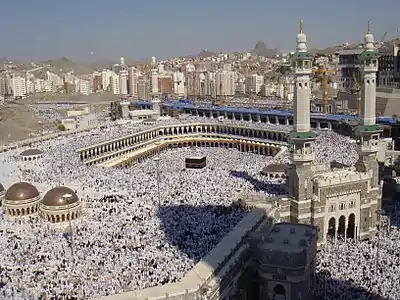Amsar
Amṣar (Arabic: أمصار), singular miṣr, are the 'garrison towns' or settlements that were established by Muslim warriors in conquered lands, in the first centuries of Islam.[1] The first were created under Caliph Omar I during his reign from 634-644 AD.[2] Many of these garrisons attracted civilians and became towns.
Description
In the frontier area of the Arabic expansion, military forts (Misr, Pl. Arabic: أمصار, amṣār), or Ribat (Arabic: رباط ribāṭ, fortress) were founded. The structure and function of a misr is similar to an ancient Roman Colonia.[3] Like a frontier colony, the fortress served as a base for further conquests. Arabian military forts of this type were frequently built in the vicinity of an older town from Antiquity or from Byzantine times. They frequently were of square format.[4]
Rather than maintaining their original purpose to serve as a military base, many amṣār developed into urbane and administrative centers. In particular, this happened in the case of the Iraqi cities of Kufa and Basra, which became known as "al-miṣrān" ("the [two] forts"), but also with Fustat and Kairouan in North Africa.
See also
References
- "Misr." In The Oxford Dictionary of Islam. Ed. John L. Esposito. Oxford Islamic Studies Online. 07-Oct-2016. <http://www.oxfordislamicstudies.com/article/opr/t125/e1532>
- Daniel H. Frank; Institute of Jewish Studies (London, England) (1995). The Jews of Medieval Islam: Community, Society, and Identity : Proceedings of an International Conference Held by the Institute of Jewish Studies, University College London, 1992. BRILL. pp. 5–. ISBN 90-04-10404-6.
- R. Hillenbrand: Anjar and early Islamic urbanism. In: G. P. Brogiolo and Bryan Ward-Perkins (Eds.): The idea and ideal of the town between Late Antiquity and the Early Middle Ages. Leiden, Brill, 1999, pp. 59–98
- Hillenbrand 1999, S. 92.
